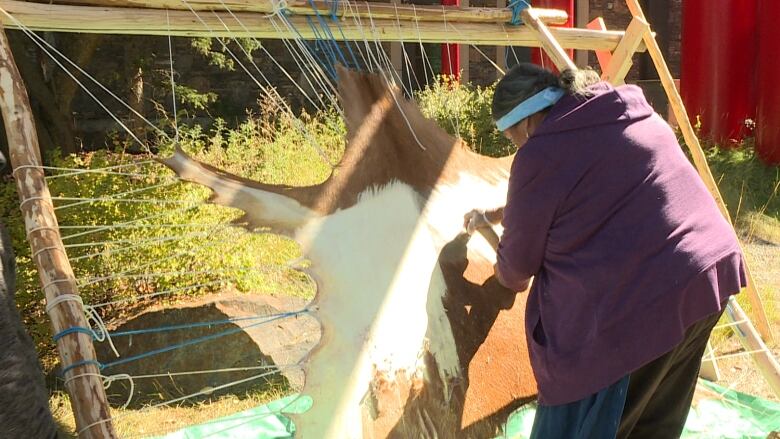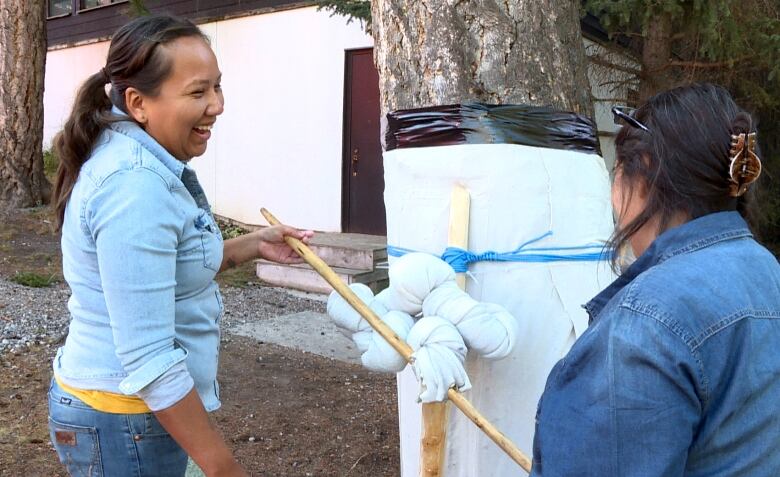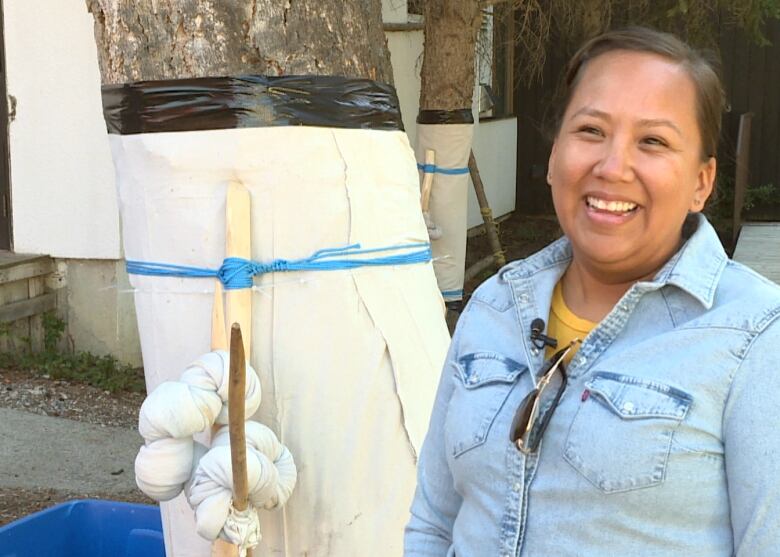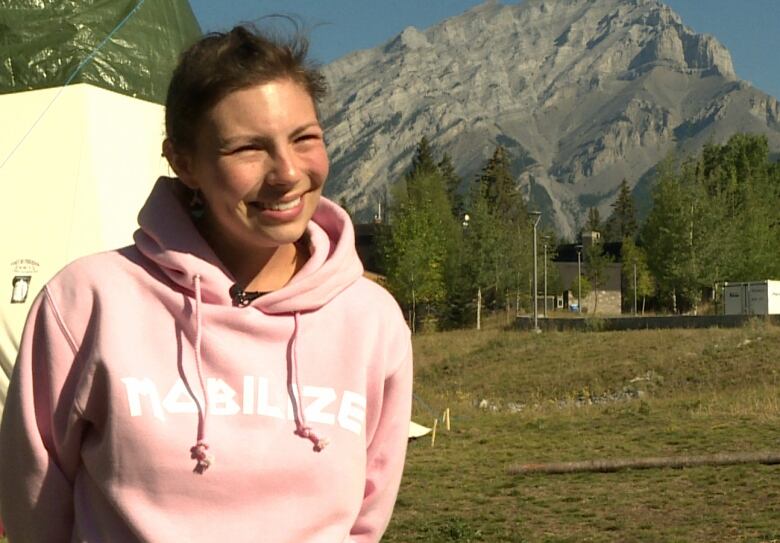Moose hide tanners learn art from elders and each other in Banff residency
New program aims to grow traditional Indigenous practice

Students are tanning moose hides this month in the mountain town of Banff, Alta., as part of a new program launched to help the traditional Indigenous practice grow.
Sarah Jean Dickie, a master's of business administration student from northern B.C., said she knew she wanted to develop her tanning skills after hunting a moose with her cousin. She turned to her grandmother to tan the hide.
"I just want to be a part of it, from start to finish," Dickie said.
Learning how to do that is difficult. Traditional hide tanning is seeing a resurgence, but practitionerssometimes have few opportunities to learn from master tanners or share knowledge with others.
As part of a series of residencies to help Indigenous arts thrive, the Banff Centre for Arts and Creativity launched its urban moose hide tanning residency on Aug. 28. It runs until Sept. 12 with a dozen studentsfrom across Canada and the United States.

The participants all have tanning experience and will learn from each other and several faculty members, including elders considered master tanners.
The program focuses on teaching two methods of tanning, one with a frame and the other with a knife. There are others, as tanning varies community to community, which are explored as students share their experiences.
"It's amazing," Dickie said. "There's so many different teachings here."

Tanning a hide is very physically demanding, said faculty memberMandee McDonald, who came to teach at the course from Yellowknife.
The students workon four moose and two deer hides, hunted in the north forthe residency. Using handmade tools, they learn, in one method, toscrape and flesh the hides before removingthe hair, then drying the hides and covering them in a paste made from the moose's brain, soap and water.The hides are then smokedfor a few days.

"When you're working on a hide, you're doing it out of respect and reverence for the land and the animals. Then thereisn't really an issue with smells or flesh or hair or bugs or anything like that," McDonald said. "The hide is very heavy, scraping the hide is really repetitive, and it requires a lot of strength and endurance and skill."
Years of practice to come, student says
Student Alyssa Gagnonbrought her two children, agedeight months and five years, to the Banff Centre as she's learning to tan moose hide, a tradition she hopes her children will one day continue.

As a woman fromTaykwa Tagamou First Nation in northern Ontario, her family historically tanned moose hide but the practice was lost to more recent generations, including to her mother and grandmother. Her grandfather was a residential school survivor, so many ways of living were lost in her family, she said.
"My grandmother is the only fluent speaker in Cree, so I think it's important that I bring these things back to my community and I practise this stuff with my children to keep the traditions going," Gagnon said.

Now living in Toronto, where she's studying midwifery, she said it's hard to practise. In Banff, she can walk in the woods to collect rotten spruce for smoking.
An elder taught her to thin hide with a knife. It was trickyto get the right angle with the knife and avoid making a hole in the hide, she said.
"It's a really challenging practice, and I'm hoping that when I go home, I can reproduce the same things," Gagnon said."But it's going to take years to really get good at it."

Faculty members are trying to be as true to tradition as possible, instructor Tania Larsson said, but some have been altered asthe group is working within Banff Centreand various policies that come in a town and national park.
"There's lots of things to think about and lots of hoops to jump through to be able to hold a hide tanning camp in an urban centre," Larsson said.
For example, the fires can't be left overnight and require a permit to be lit, Dickie said. That'sa bit different from smoking in your ownrural backyard.
"You see all the work that goes into it. I don't think people really value or understand how much," she said.
Tanners fromDeneNahjo, a leadership collective, and Fort Good Hope in the NorthwestTerritories are instructing, along with elders from nearby StoneyNakoda. Participants come from nations includingDene, Cree,Mi'kmaq, StoneyNakoda, Tlingit andAnishinaabe.
The new year-round Indigenous Arts program is launching on Monday with a public showcase of the hide tanning residency's work, as well as a panel discussion.
- MORE ALBERTANEWS |Calgary metal detectorist seeks owner after digging up gold ring inscribed 'Audrie'
- MORE ALBERTANEWS |Calgary tattoo shop covers up 'worst of the worst' body art in Facebook contest
- MORE ALBERTA NEWS |Drumheller dinosaur statues need saving after slight 'mass extinction,' group says
- Read more articles byCBC Calgary, like us onFacebookfor updates and subscribe to ourCBC Calgary newsletterfor the day's news at a glance.
With files from Radio-Canada's Nelly Alberola, Elizabeth Withey and theCalgary Eyeopener.












_(720p).jpg)


 OFFICIAL HD MUSIC VIDEO.jpg)
.jpg)



























































































